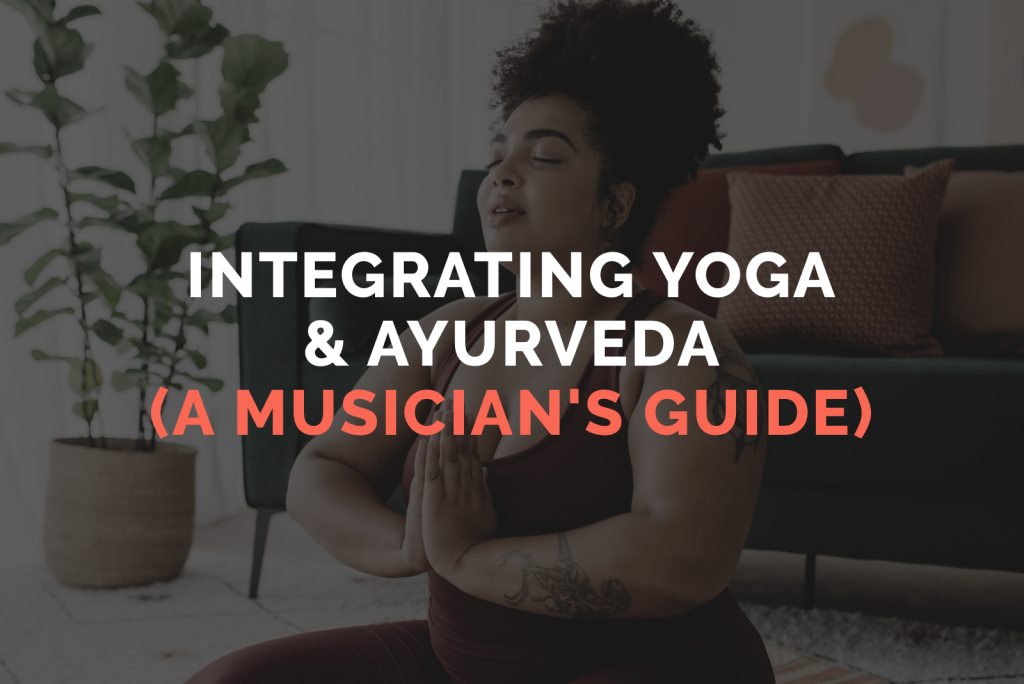Your Hearing Superpower: Integrating Yoga & Ayurveda (A Musician’s Guide)
Our senses are precious. Without them, we couldn’t enjoy the world in all its wonders. As musicians, our sense of hearing is our superpower. We define, create, and express through it. Without it, how would we do what we love?
This is a guest post by global Yoga teacher and singer-songwriter Rachel Zinman.
Hearing and sound are intimately intertwined because they exist through the medium of space. The more space, the more notes have meaning. Sounds are married to space; they can’t escape space. Sounds are also married to silence. Without silence, what sound?
Have you ever thought about space and how subtle this element is? How space makes way for music? How it has no boundaries and how there is no beginning or end to it?
The subtlety of space also relates to our individual physical constitution. We are made up of five elements: earth, water, fire, air, and space. Space is the finest element and exists in our cells.
As a musician, no matter what your instrument, space is inseparably part of you. You are the space. Silence and stillness are also inherent in your existence. When we work hard on a project, when we get stressed with overwork through practice, creation, touring, etc., we lose sight of this. The space element in our bodies and minds goes out of balance. We can feel ungrounded, anxious, overwhelmed, and have insomnia. Having a crazy schedule with late nights or irregular hours adds to this imbalance.
So, how can we harness the element of space and the power of sound to come back down to earth and thrive in both body and mind as a creative artist?
Here’s where the power of yoga and Ayurveda can help.
In Ayurveda, the Indian science of health and healing, each person has a unique constitution. Our constitution is the distinctive mix of elements in our bodies. Some of us might dominate with more water and earth, others with fire and water, and creative types tend to have more air and space. That’s not a bad thing. It makes you free in your thinking, intuitive, imaginative, and flexible.
It’s only when we expose ourselves to external factors which increase the air and space in our system, that we fly too high. Think about how it feels after a gig, or when you’re grooving on an idea in the studio into the night. How long does it take you to settle down?
When one or more elements are out of balance in the body, Ayurveda uses the opposite element to bring the body, mind, and emotions back into balance. In other words, if you have too much air and space influencing your constitution, bring in water and earth.
As a musician, what does that practically entail?
It might mean setting up a routine for yourself after a late night. Practicing somatic exercises that calm the nervous system. Having a warm, healthy, wholesome meal with root vegetables as opposed to fast food takeaways. Taking a warm bath and trying some calming breathing practices before bed with an aim to sleep between 7-8 hours.
It also means devising periods of rest and recuperation after times of intense touring and musical creation. Taking time away from screens in a natural environment to restore your creative juices.
Working as a musician and playing an instrument is a repetitive activity that can challenge you physically. Finding movement practices like Yoga or Tai Chi can stretch, free, and strengthen areas that habitually tense up through repetition.
If you do choose a movement practice, make sure it’s calming and includes restorative practices. Yin yoga is all the rage now, but it’s not one size fits all. Sometimes long holds in postures that stretch ligaments and tendons can release unconscious trauma and do more harm than good.
Make sure to find a reputable, experienced teacher and a style of yoga that works for you. Your body is your instrument. Whether you sing or play an instrument, you want to take good care of it.
Sound is our greatest healer. Humming vibrates the pituitary gland, which sits in the middle of our brain in a fluid sac. The pituitary gland is the master gland and harmonizes all the other glands in the body. Chanting the sound Om or simply making the sound Hum will tune up all the glands in the body, enabling them to function better.
The Humming Bee Breath is something you can do not only to warm up vocal cords but to balance your energy and tune up your immune system and harness the element of space.
Here’s a simple explanation below:
Sit in a comfortable position with your spine straight and shoulders relaxed. You can sit on a chair or cross-legged on the floor.
Gently close your eyes to enhance focus and relaxation.
Use your palms to gently cover your ears, blocking external sounds.
Take a deep breath in through your nose, filling your lungs completely.
As you exhale, make a gentle humming sound, like the sound of a bee. Keep the mouth closed and feel the vibration in your throat and head.
Continue to focus on the humming sound and the soothing vibrations it creates.
Repeat this process for 5-10 rounds, or as long as feels comfortable.
By integrating these simple suggestions and practices into your routine, you might find that even though your lifestyle demands irregularity and intensity, you can still find ways to calm and balance your mind and nervous system.
A little bit of awareness and application goes a long way. As a musician, you know how to practice and what it takes to bring the seed of creation to fruition. Now, all you need to do is apply these principles to your daily life to enhance your well-being and continue to create beautiful music.

